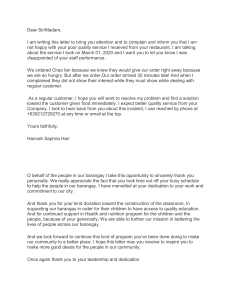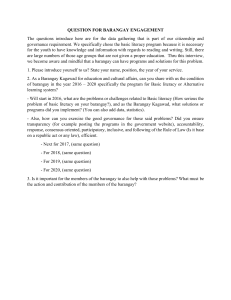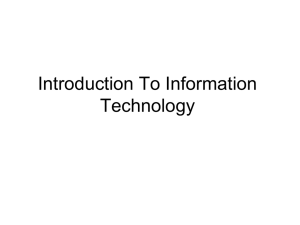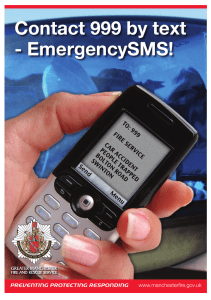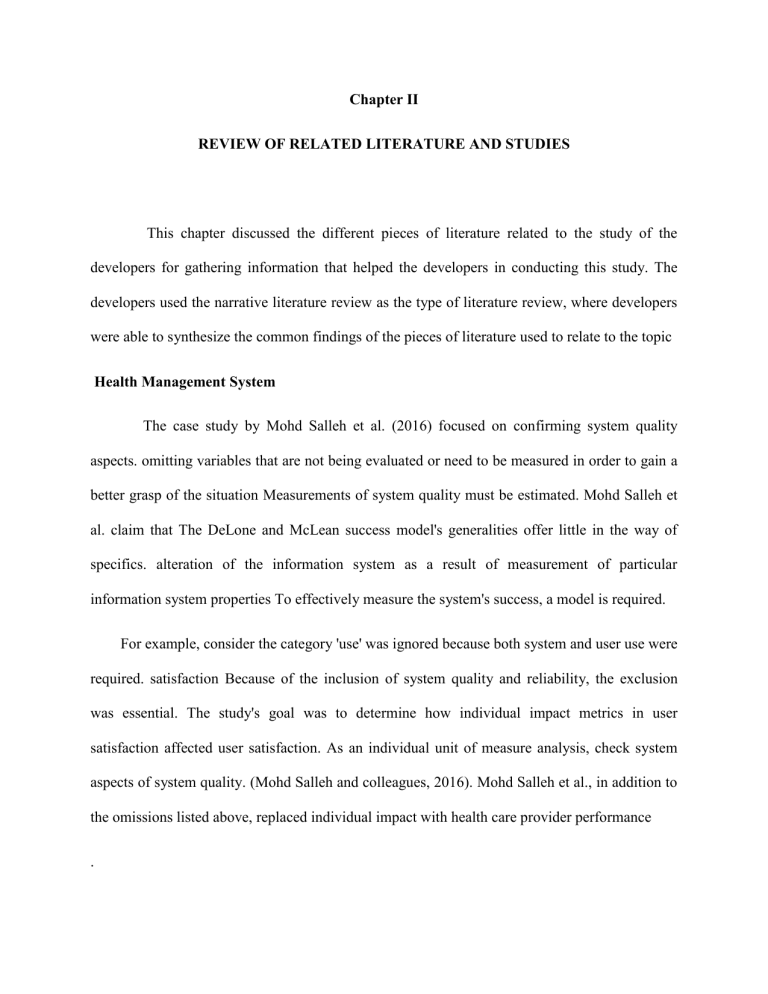
Chapter II REVIEW OF RELATED LITERATURE AND STUDIES This chapter discussed the different pieces of literature related to the study of the developers for gathering information that helped the developers in conducting this study. The developers used the narrative literature review as the type of literature review, where developers were able to synthesize the common findings of the pieces of literature used to relate to the topic Health Management System The case study by Mohd Salleh et al. (2016) focused on confirming system quality aspects. omitting variables that are not being evaluated or need to be measured in order to gain a better grasp of the situation Measurements of system quality must be estimated. Mohd Salleh et al. claim that The DeLone and McLean success model's generalities offer little in the way of specifics. alteration of the information system as a result of measurement of particular information system properties To effectively measure the system's success, a model is required. For example, consider the category 'use' was ignored because both system and user use were required. satisfaction Because of the inclusion of system quality and reliability, the exclusion was essential. The study's goal was to determine how individual impact metrics in user satisfaction affected user satisfaction. As an individual unit of measure analysis, check system aspects of system quality. (Mohd Salleh and colleagues, 2016). Mohd Salleh et al., in addition to the omissions listed above, replaced individual impact with health care provider performance . Health Information System Health and immunization access in selected Asian countries such as Cambodia, Indonesia, Mongolia, Myanmar, Philippines, and Myanmar have low immunization coverage. This problem is resulting in the outspread of communicable disease outbreaks in Asia. The “reaching every purok” strategy 9 refers to visitation in every barangay in rural and urban locations (Grundy et al., 2019). Exchange of information is needed for all system devices and components to effectively communicate as intended, providing safe and reliable cohesive information (Weininger and colleagues, 2016). Health information systems are complicated, and promoting them is difficult. diverse devices, people, and systems in an efficient HIE (including subsystems), An enterprise information system's interoperability is critical (Weichhart et al.).(2016, et al.) In terms of technology, the paperless feature and the system's capacity to integrate with existing technologies are enablers for HIS adoption. According to Budget reports, expenses for paper-based transactions have decreased in the last three years since the system's installation (Ebardo and Tuazon, 2019). Because the processes involve multiple divisions within the organization, system integration is critical. Because it can readily interact with many systems that the company need, HIS provides scalability and flexibility. Health information system for decision support The Implementation of a Health Information System along with a Decision Support System has greatly increased the efficiency of the process from the 10 registration of the users with different types of access to recommendations of the targets and health programs (Estinar et al., 2018). The system that is capable of the generation of reports, storage, and consolidation of patient records will support the recommendation of well-informed decisions along with the visualized data that can be easily understood by barangay officials and health personnel. The Decision Support System (DSS) or the Clinical Decision Support System (CDSS) uses electronic health records (EHRs) often. These EHRs are administered through a desktop, where the outputs may not be produced directly on the desktop or it may be linked to a database for EHRs (Sutton et al., 2020). The EHRs contain the personal record, medication record, medical histories, examinations, and procedures taken by a patient (Department of Health, 2013). Doctors use EHRs to have a better track of a patient’s health information. EHRs make the information to be shared from doctors to specialists easier, which helps specialists for seeking the information needed from the patient (Health Information Technology, 2017). Synthesis of the state of the art The system presented were obtained from both foreign and local system study that were made basis for the developed of health management system. It describes some features that are available on the system but some are not available with the local and foreign study. According to the journal entitled, Reducing the frequency of errors in medicine using information technology; appropriate use of information technology in health care resulting in process simplification could result in substantial improvement in patient safety. The growing demand for the quality healthcare should carry out planning, monitoring and controlling the delivery system. This characteristics are the main features of the Barangay Health Management System. Thus, the related system shares similar nature to the study but the proponents observed the lack of features which are important such as management of patients’ health records; automated management system; secure log-in system; inventory of medicines; generate the monthly reports to the CHO. Hence, the proposed system includes all the needed features specifically tailored for olag pequeno Health Center. Gap Bridged by the Study In this generation, most of the advantage using the cellphone for reminders is the fact that patients will bring their cellphone almost anywhere every time, thus decreasing the chances of forgetting the reminder. The potential benefits of using the cellphone for health applications include follow-up reminders and easy to get the record of the patients. Theoretical framework This study was anchored on the following theories: (1) Sharon Hurley Hall- February 17, 2016 (2) Headquarters- 2002 theory (3) Nurzety Aqtar Ahmad Azuan- March 2005 theory The SMS advantages in Health Care institutions wishing to engage with their patients via SMS should pay attention to these data. SMS can assist with a variety of aspects of the healthcare process, including delivering appointment and follow-up reminders to patients, providing information about schedule changes, and providing timely medical advice, among other things. Because messages are sent to individual phones, SMS has the added benefit of making communication feel more personal. It's intended to be a tool that doctors and registrars may use to keep track of their outpatients. Patient demographics and other critical information for group clinics, such as the registration process, are designed to give better service to patients. Reduce the registrar's workload by making all data more accessible without wasting time, as opposed to the manual procedure of searching the archive for patient data, which takes more effort and time. SMS Delivers Patient Support in Many Form theory (2016) Patient Record Management System theory 2002 Barangay health management system Clinic Management System outpatient Management System theory (2005) Figure 1 Theoretical Paradigm Conceptual Framework The conceptual framework shows and indicates the flow of the system and helps the users and all the readers understand how it will be processed. This study intends to improve the existing manual way of Barangay Olag Pequeno Health Center. The Barangay Health Management System is an automated information system that is designed for keeping, and evaluating the residents’ heath records. Input - medical record of the patient, making sms notification, population base patient, monitoring Process – encoding the records disseminating the information of the patient, efficient to monitor the household census Output – health center management system, with sms notification. Feedback- The process of revising sms notification based on the patient health concern. Input - medical record of Process – encoding the Output – health center the patient, making sms records disseminating the management system, with notification, population base information of the patient, sms notification. FEEDBACK Figure 2 Conceptual Framework This study had four variables that were considered as the key ideas while using the IPO approaches. These were the designer, the system itself, customers or users, and customer service. The designer was the person who developed the health center management system as online support of the community using a web programming language (PHP and other applicable languages for the system). The purpose of the designer was to build a notification for the patients. delivering assistance to the customers. Barangay health center was the output that will be used for resolving the stated problems of the patients. This will serve as online using sms notification support that can communicate to patients and help the existing system of the barangay for providing assistance. The third variable was its users. This includes patients, nurse, and barangay health worker (BHW). While the patient service was the last variable that will be the basis of the designer (influence and experience).

